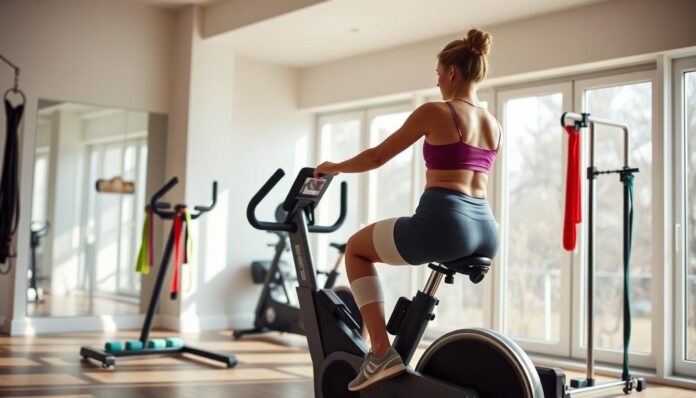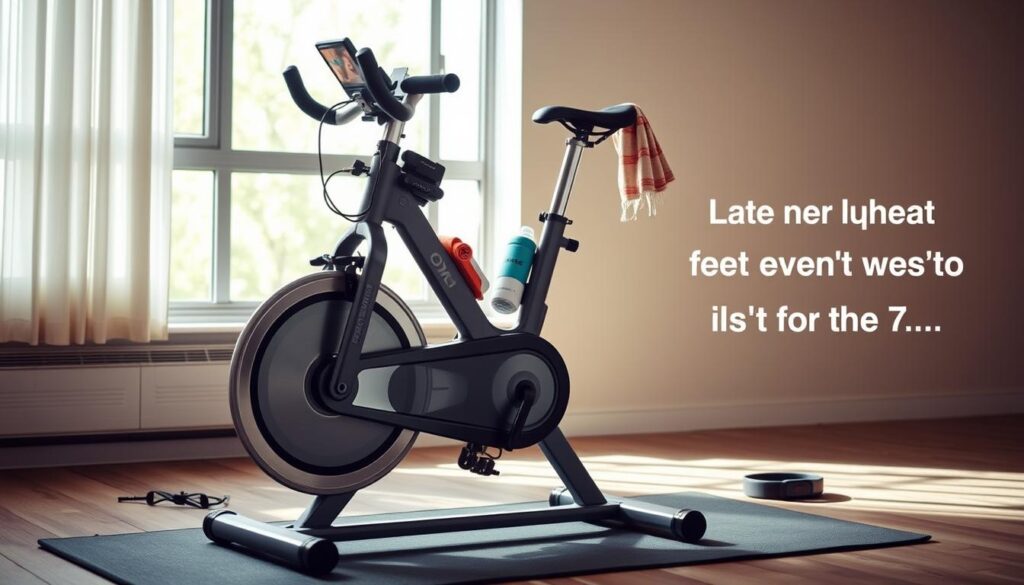Recovering from a leg injury doesn’t mean you have to stop exercising. You can keep your heart rate up and stay healthy while your leg heals. We’ll look at four cardio workouts that are safe for your injured leg. They’re designed to keep your heart rate up without hurting your recovery.
Key Takeaways
- Maintaining cardio fitness during leg injury recovery is possible with the right exercises
- Swimming, water aerobics, and stationary bike provide low-impact cardio options
- Yoga and Pilates can strengthen core and improve stability, aiding recovery
- High-Intensity Interval Training (HIIT) offers rigorous cardio without stressing the injured leg
- Consulting a healthcare provider is key to ensure safe and effective workouts during rehabilitation
Swimming and Water Aerobics: The Zero-Gravity Workout
Dealing with a leg injury can make it hard to keep up with your workout routine. But, water offers a way to keep fit without putting too much stress on your leg. Swimming and water aerobics are perfect for people with leg injuries because they feel like you’re working out in space.
The Healing Power of Water
Water’s buoyancy is a big help when you’re recovering from a leg injury. It supports your body, so you don’t put too much pressure on your injured leg. This lets you exercise without hurting it more, helping you heal faster.
- Water provides about 15 times more resistance than doing the same moves on land.
- Swimming workouts can burn up to 800 calories in one session.
- Water aerobics sessions count as full-body workouts, building strength and working the cardiovascular system.
Water also lets you do deeper movements before you get tired, making your workouts more effective. Plus, water exercises work more muscles and joints than swimming, making them a better choice for staying fit.
“Water supports body weight in high-intensity training without stress on joints, allowing deeper pushes before fatigue and quicker recovery.”
If you want to keep fit or help your leg heal, swimming with an injured leg and water aerobics with leg injury are great options. The buoyancy of water and aquatic therapy for leg injury can be key in your recovery and better health.
Stationary Bike: Low-Impact Cardio Solution
If you’re dealing with a leg injury, a stationary bike can be a game-changer. This low-impact cardio machine lets you raise your heart rate without stressing your injured leg too much. It’s safe and effective for keeping fit while avoiding further injury.
Proper Setup and Form
When using a stationary bike, proper setup and form are key. Adjust the seat so your leg is almost fully extended at the bottom of the pedal stroke. Choose a resistance level that fits your fitness and injury status. Keep good posture, engage your core, and avoid putting too much pressure on your injured leg.
Interval Training
To get the most out of your stationary bike workouts, try interval training. This means switching between high-intensity and low-intensity periods. For example, pedal hard for 30 seconds, then spin easier for 1 minute. This method boosts your heart health without stressing your injured leg too much.
| Workout Type | Calories Burned (100 cal) | Duration |
|---|---|---|
| Stationary Bike | 5-7 minutes | Same as running 1 mile |
| Tabata Interval Training | 100 calories | 10 minutes |
Consistency is key. Adding a stationary bike to your routine helps keep your heart healthy and keeps you active while healing. Always check with your healthcare provider to make sure your workout plan is right for your injury and recovery.
“Spin workouts are recommended by physical therapists as one of the best exercises for bad knees due to its low impact.”
Yoga and Pilates: Core Strength and Stability
If you have a leg injury, you don’t have to stop working out. Yoga and Pilates are great for core strength and stability. They help you stay active while your leg heals. These practices focus on your abdominal and back muscles, making them safe and effective.
Pilates is great for improving flexibility and range of motion. It helps you recover from injuries faster. The controlled movements of Pilates exercises work all major muscle groups, balancing your muscles and preventing future injuries.
Yoga has many modified poses for leg injuries. You can do Warrior III, Tree Pose, and Crescent Lunge to work your core and stability without putting too much weight on your injured leg. A good yoga teacher will help you do these poses safely and effectively.
Pilates with leg injury also has exercises that focus on core strengthening with leg injury and stability exercises with leg injury. Try Shoulder Bridge, Leg Lifts, and One Leg Circle to work your muscles without stressing your injured leg.
Choosing yoga or Pilates can be key in your injury recovery. They help you keep your fitness level up and support your healing. This way, you’ll come back to your active life stronger and more resilient than ever.
High-Intensity Training (HIIT): Effective Low-Impact Workouts
If you have a leg injury, you might think you can’t do cardio workouts. But there’s hope! High-Intensity Interval Training (HIIT) is a low-impact way to keep your heart rate up and muscles working. It doesn’t put too much stress on your injured leg.
Low-Impact HIIT
For HIIT with a leg injury, choose exercises that are easy on your joints and ligaments. You can try:
- Cycling (indoor or outdoor)
- Rowing or using a SkiErg
- Elliptical training
- Jumping jacks or modified jumping jacks
- Step-ups or step-backs
- High knees or side-to-side shuffles
These low-impact moves in your HIIT routine can keep your heart rate up. You’ll get the benefits of high-intensity training without hurting your injury.
Cardiovascular Benefits
HIIT workouts are great for your heart and metabolism. They help you burn calories fast. Even with a leg injury, you can enjoy these benefits with low-impact HIIT. Research shows HIIT improves your fitness, both for quick and long-term efforts.
Safety First
When doing HIIT with a leg injury, safety is key. Always warm up well, listen to your body, and adjust or skip exercises if needed. It’s smart to talk to your doctor to make sure your HIIT is right for you. With care, you can get the most out of HIIT while your leg heals.
Cardio Workouts With Injured Leg: Maintaining Fitness
Keeping fit while recovering from a leg injury is key for your health. You might not be able to do all your usual cardio, but there are good alternatives. These options help you stay active and keep your heart healthy.
Swimming or water aerobics are great because they’re easy on your injured leg. The water supports your body, letting you work out without hurting your leg. Stationary cycling is also a good choice. It’s easy on your leg and gives you a tough workout.
If you want something more intense, try Tabata workouts. They’re short, high-energy bursts of exercise followed by quick breaks. This way, you can keep fit without stressing your injured leg too much.
| Cardio Option | Benefits | Considerations |
|---|---|---|
| Swimming/Water Aerobics | Low-impact, full-body workout | Requires access to a pool |
| Stationary Cycling | Low-impact, can be done at home | Ensure proper form and resistance |
| Tabata Workouts | High-intensity, time-efficient | Requires caution to avoid re-injury |
It’s very important to talk to your doctor or physical therapist about your workout plan. They can help you find safe and effective exercises for your injury. Staying active and fit will help you recover faster and get back to your normal activities sooner.
Precautions and Mindset: Healing as a Priority
Dealing with an injured leg means you must take care and focus on recovery. It’s important to talk to your healthcare provider. They can help pick safe exercises for your injury.
Liz Letchford, an injury expert, says wait at least 72 hours after injury to heal. She warns against exercising with concussions, spine injuries, or heart problems. If an exercise hurts, stop right away.
Consult Your Healthcare Provider
Having the right mindset is vital during recovery. See your injury as a chance to try new things and focus on getting better. Trainer Caroline Jordan says choosing safe, smart exercises is key.
- Low-impact or non-weight-bearing workouts like aqua jogging or floor exercises are safe, Jordan suggests.
- Avoid high-impact or explosive movements to prevent re-injury or more pain.
By being careful, talking to your healthcare provider, and staying positive, you can stay active. This helps you focus on recovery from the leg injury.
Cycling: Pedaling Through Injury
When you have a leg injury, cycling is a great way to keep your heart rate up. You can use a stationary bike or ride outside. Both options are low-impact and let your leg heal while you stay active.
To start, adjust your bike to feel right. Try different seat heights, pedal positions, and resistance levels. This helps you stay comfortable and focused on recovery.
- Stationary bike cycling: Allows you to control the intensity and monitor your progress while minimizing stress on your injured leg.
- Outdoor cycling: With the right modifications, such as using a recumbent bike or a tandem, you can enjoy the benefits of cycling outdoors during your recovery.
- Modified cycling techniques: Explore options like one-legged cycling or adjusting your pedal stroke to accommodate your injury and maintain your fitness.
It’s important to listen to your body and start slow. As your leg gets better, you can make your workouts harder. Cycling can be a big help in your recovery.
“Cycling is a great way to maintain cardiovascular fitness while allowing your leg to heal. By adjusting the resistance and setup of your bike, you can customize the workout to your comfort level.”
Core Exercises: Building Strength Without Stress
Even with a leg injury, you can work on your core muscles. This helps keep your balance and prevents more injuries. Core workouts are great for staying active and improving fitness while you recover.
Tabletop Crunches and Variations
Tabletop crunches are a low-impact exercise done while lying flat. They target your abs without stressing your injured leg. Try adding leg lifts and hollow hold to make it harder.
- Tabletop Crunches: Lie on your back with knees bent and feet flat. Engage your core and lift your shoulder blades, keeping your lower back down.
- Leg Lifts: Lie on your back with legs straight. Engage your core and lift your legs up, keeping your lower back down.
- Hollow Hold: Lie on your back with arms overhead and legs straight. Engage your core to lift your body into a “hollow” shape.
These exercises help build core strength without stressing your injured leg.
Research from Ohio State University Wexner Medical Center found most people have weak deep core muscles. Runners with weak deep core muscles are more likely to get low-back pain. Adding these low-impact core exercises to your routine can strengthen your core and support your health during recovery.
Upper Body Lifting: Focusing on Neglected Muscles
When you have a leg injury, it’s a great time to work on your upper body lifting. You can do bench press, bicep curls, tricep extensions, and shoulder raises without hurting your leg. This keeps your upper body strength up while you recover.
Studies reveal that chest, back, and shoulders often get less attention from female gym-goers. Many women focus more on their core, lower body, and cardio because of social media and fears of getting too big. But, training the upper body is just as vital for a balanced look and health.
Adding upper body lifting to your routine targets muscles like the serratus anterior and pectoralis minor. These muscles are bigger than the lats. Weakness in them can cause scapula winging, which limits shoulder movement and strength. The “pushup plus” is a good exercise for these muscles.
Start with light weights and fun exercises when you add new ones to your routine. This makes it easier to stick with it and see lasting results in your arm and shoulder workouts with leg injury.
| Muscle Group | Potential Issues from Neglect | Recommended Exercises |
|---|---|---|
| Serratus Anterior | Scapula winging, restricted shoulder mobility and strength | Pushup Plus |
| Pectoralis Minor | Scapula winging, restricted shoulder mobility and strength | Pushup Plus |
| Rhomboids | Chronic back pain | Seated Rows, Face Pulls |
| Gluteus Medius | Hip, knee, and low-back function issues, special in runners | Lateral Band Walks, Clamshells |
| Psoas | Reduced stride length, impact on walking, running, and stair climbing | Kneeling Hip Flexor Stretches |
By focusing on your upper body lifting with leg injury, you can keep and even grow your arms and shoulders strength. This prepares you for a balanced and symmetrical body once your leg heals.
Yoga Modifications: One-Legged Poses and Floorwork
Even with a leg injury, you can keep your yoga practice going. You can do modified one-legged poses and floorwork. These exercises work your upper body and the leg that’s not hurt. They also help with neural stimulation and strength.
Neural Stimulation and Strength Gains
Studies show that working one limb can make the other stronger. This is called neural stimulation. It’s great for recovery because you can keep working out the good parts of your body. This lets the hurt leg heal.
- One-legged yoga poses, like Balancing Half Moon and Warrior III, boost balance and lower body strength.
- Floorwork, such as Tabletop Crunches and Leg Lifts, strengthens your core and upper body without hurting your injured leg.
- These yoga and floorwork changes help you stay fit and even get stronger in the good leg through neural stimulation.
Adding one-legged poses and floorwork to your yoga keeps you active and focused on healing. This way, you’ll come out of your recovery period stronger and more resilient.
Swimming: Buoyancy for Low-Impact Cardio
If you’re recovering from a leg injury, swimming is a great way to stay active. Water’s buoyancy reduces pressure on your leg. This lets you do cardio without hurting your healing body.
Almost one in five people in the U.S. swim every year. Swimming is a low-impact exercise that’s good for you. A 160-pound person can burn 420 to 700 calories an hour. A 240-pound person can burn 600 to 1,050 calories in the same time.
Swimming also lowers death rates by 50% over 32 years. Kids who learn to swim do better in school and physically than those who don’t.
Swimming helps people with certain conditions too. MS patients who swam for 20 weeks felt less pain and fatigue. It also helps with osteoporosis by increasing bone density and improves flexibility and reduces inflammation for arthritis patients.
If you have a leg injury, try water workouts. The water’s resistance and buoyancy make for a tough yet easy cardio workout. Always talk to your doctor before starting.
“Swimming can help enhance sleep quality and cognitive function. Vigorous exercise like swimming also promotes the production of endorphins, helping combat stress, anxiety, and depression.”
Conclusion: Staying Active and Healing
An injured leg can be tough, but staying active helps with healing. Low-impact cardio exercises like swimming, cycling, and yoga are great. They keep your heart healthy and spirits up during recovery.
It’s vital to work with your healthcare provider or physical therapist. They can create a safe and effective workout plan for you. This way, you can stay active, keep fit, and find good cardio options. Always remember the importance of healthcare provider guidance and safe workouts.
Being proactive and working together with your healthcare team is key. You can stay active, keep fit, and help your leg heal. All while focusing on your overall health and well-being.
FAQ
What are some effective cardio workouts I can do with an injured leg?
Good cardio options for injured legs include swimming, water aerobics, and using a stationary bike. Yoga and Pilates are also great. Plus, low-impact high-intensity interval training (HIIT) is effective.
How can swimming and water aerobics help with an injured leg?
Swimming and water aerobics are great for injured legs. They offer a weightless environment, reducing stress on the leg. This makes them perfect for those with leg injuries, helping in recovery.
How can a stationary bike be a good cardio solution for a leg injury?
A stationary bike is a good choice for leg injuries. It provides a cardio workout without further injury. Adjust the resistance and add interval training for a better workout.
How can yoga and Pilates help with a leg injury?
Yoga and Pilates are good for leg injuries. They focus on core strength, helping with limited leg mobility. There are safe, modified poses and exercises for these practices.
How can high-intensity interval training (HIIT) be done safely with a leg injury?
HIIT is safe for leg injuries if done low-impact. It boosts heart health and burns calories. Always warm up, modify exercises, and take precautions for a safe workout.






